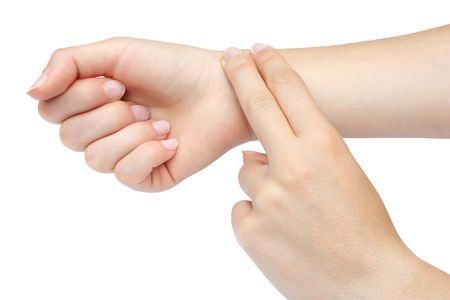
A personal trainer has many variables to assess, manage, and modify during even a single personal training session. The three most ubiquitous variables with regard to exercise are frequency, duration, and intensity. The first two are well, pretty straightforward. But what is the best way to gauge intensity, especially when we have to differentiate between aerobic and anaerobic efforts? Taking a client’s pulse is a basic skill that a trainer should know for gauging intensity.
Some people prefer to judge intensity by signs such as how hard they breathe (by means of a talk test), or noticing how much they perspire. Unfortunately, neither method is the best means of gauging true aerobic intensity levels. A more accurate way to determine the intensity of aerobic exercise is to measure the pulse. This is because a person’s pulse is a reflection of how hard his or her heart is working. The heart rate, in turn, determines oxygen uptake level: The higher the level, the greater the oxygen uptake.
There are two main ways in which someone can take his or her own pulse: using the fingers placed over a pulse point and counting, or using an electronic device to do most of the work.
The ‘Hands-on’ (Manual) Method of Taking a Pulse
Using the manual method employs a combination of tactile sensation and some basic math to arrive at an approximate measurement of the pulse: Once your fingers find a pulse, count the number of beats you feel within the span of a single minute. It’s possible to estimate the per-minute rate by counting for 10 seconds and multiplying this figure by 6, (or by counting over 15 seconds and multiplying by 4, or over 30 seconds and doubling the result).
A pulse can be noticed anywhere an artery is near the surface of the body, but the two points most commonly used to take the pulse are on the neck and on the wrist.
- Carotid Pulse (neck) – To take the heart rate at the neck, place your index and middle fingers on either side of the neck (being careful not to press too hard) at about the same level as the Adam’s apple, and then count the number of beats for a minute. Putting too much pressure on the carotid artery slows the heart rate almost instantly, resulting in an inaccurate measurement.
- Radial Pulse (wrist) – This method uses the radial artery at the base of the wrist. Place your index and middle fingers together on the other wrist, about 1/2 inch on the inside of the joint in line with the index finger. Use your index and middle fingers (not the thumb—it is supplied with its own artery), and then count the number of beats in your chosen timeframe.
Ultimately, both methods involve the use of technology – a watch or clock needs tp be used for an objective and accurate measure of time.
Pulse Taking Limitations
These manual techniques of taking the pulse, while quite handy (no pun intended), do have some inherent limitations. A primary issue is that in order to obtain an accurate measurement, it is necessary to stop exercising. Practice helps, but until one becomes proficient at obtaining a quick measurement, it is to be expected that the pulse will start to drop quickly. This factor alone will often produce an inaccurate measurement.
To complicate matters, in the case of the palpation of the carotid artery, the sudden slowing of heart rate can lead to dizziness, fainting, or in some cases, irregularities in heart rhythm.
For obvious reasons, electronic heart rate monitors have been designed to get around these issues and as a result, if used and worn correctly, they can yield much more accurate results.
The Body Electric: Electronic Heart Rate Monitoring
An electronic heart rate monitor uses a different means of measuring heart rate, mimicking the function of an electrocardiogram. A typical set-up consists of a strap worn on the chest, and a wristwatch such as many models made by Polar. The strap has two small electrodes that detect the equivalent of the “R” wave on an electrocardiogram (ECG). This R-wave represents the contraction of the heart, or “systole” phase, and the measurement isn’t affected by body movement.
This measurement is transmitted to the wristwatch, which displays the information on its face. Some monitors are capable of recording heart rate changes over short time periods, and can record changes in heart rate to allow for later review or storage on an external computer. The data can be used to calculate calories burned, time elapsed in a target zone, and maximum oxygen intake, among other related measurements.
But portable electronic heart rate monitors are not without their own set of issues, either.
If the chest strap isn’t worn properly, it can cause inaccurate or no readings. In addition, many heart rate monitors require at least some perspiration to be present between the chest strap and the skin for best conductivity. A quick solution is to apply a small amount of lotion, water, or conductive gel until the amount of perspiration is sufficient to create good contact.
Final Thoughts
Taking a pulse efficiently and accurately can take practice and patience. Practice on yourself or a friend or family member at rest and while exercising if you do not feel confident doing so on a client right away. Also, no harm in being forthright with your clients: “I’m new to the pulse-taking technique so bear with me.”
Of course, most of our clients today are adorned with their own heart rate monitors in watch or Fitbit form, and may possibly save you the trouble. However, bear in mind these are not always accurate and reliable, so it may still behoove you to get a manual reading and compare it to the watch or heart rate monitor data.







